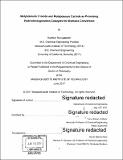| dc.contributor.advisor | Yuriy Román-Leshkov. | en_US |
| dc.contributor.author | Murugappan, Karthick | en_US |
| dc.contributor.other | Massachusetts Institute of Technology. Department of Chemical Engineering. | en_US |
| dc.date.accessioned | 2017-09-15T15:32:41Z | |
| dc.date.available | 2017-09-15T15:32:41Z | |
| dc.date.copyright | 2017 | en_US |
| dc.date.issued | 2017 | en_US |
| dc.identifier.uri | http://hdl.handle.net/1721.1/111404 | |
| dc.description | Thesis: Ph. D., Massachusetts Institute of Technology, Department of Chemical Engineering, 2017. | en_US |
| dc.description | Cataloged from PDF version of thesis. | en_US |
| dc.description | Includes bibliographical references (pages 171-176). | en_US |
| dc.description.abstract | Growing concerns due to rising CO2 emissions have made biomass an indispensable source of renewable fuels and chemicals. However, biomass inherently has high oxygen content, which translates to low energy density, thereby necessitating a deoxygenation step before being utilized as fuels. Recently, MoO3 and Mo2C have emerged as promising earth-abundant cheap catalysts that perform hydrodeoxygenation (HDO) at relatively low temperatures ( 673 K) and ambient H2 pressures wherein oxygen is selectively removed as water. However, there exists a significant knowledge gap in understanding the stability and the active phases responsible for HDO of these catalysts. Furthermore, their applicability for real biomass conversions has not been largely demonstrated. In this thesis, first, HDO of m-cresol, a biomass-derived model compound, is investigated over bulk and supported MoO 3 catalysts. Detailed reactivity and characterization studies reveal that Mo5+ species plays a critical role during HDO. Specifically, TiO2 and ZrO2 are identified as ideal supports as they feature superior HDO reactivity and stability over bulk MoO3 by stabilizing intermediate Mo oxidation states (i.e. Mo5+) while bulk MoO 3 over-reduces to inactive metallic Mo. Translating from model compound studies, supported MoO3 catalysts are demonstrated to be effective in converting biomass (pine) pyrolysis vapors to hydrocarbons (ca. 30 % yield). In comparison with MoO 3, Mo2C is significantly more stable and selective for HDO of 4-methylanisole to toluene under identical reaction conditions. Mo2C predominantly breaks the stronger phenolic C-0 bond while MoO 3 also breaks the weaker aliphatic C-0 bond, likely due to the presence of Bronsted acid sites. To gain insights into the surface active sites, operando near-ambient XPS is employed during HDO and this technique revealed that HDO seems to operate via distinct active sites over both these materials. Finally, Mo2C is shown to be effective in upgrading real lignin streams to a single product propylbenzene, a precursor for renewable polymer. Overall, this thesis demonstrates the applicability of MoO3 and Mo2C in real biomass conversions and provides insights on the working nature of these catalysts, which will enable the design of more effective HDO catalysts. | en_US |
| dc.description.statementofresponsibility | by Karthick Murugappan. | en_US |
| dc.format.extent | 176 pages | en_US |
| dc.language.iso | eng | en_US |
| dc.publisher | Massachusetts Institute of Technology | en_US |
| dc.rights | MIT theses are protected by copyright. They may be viewed, downloaded, or printed from this source but further reproduction or distribution in any format is prohibited without written permission. | en_US |
| dc.rights.uri | http://dspace.mit.edu/handle/1721.1/7582 | en_US |
| dc.subject | Chemical Engineering. | en_US |
| dc.title | Molybdenum trioxide and molybdenum carbide as promising hydrodeoxygenation catalysts for biomass conversion | en_US |
| dc.title.alternative | MoO₃ and Mo₂C as promising HDO catalysts for biomass conversion | en_US |
| dc.type | Thesis | en_US |
| dc.description.degree | Ph. D. | en_US |
| dc.contributor.department | Massachusetts Institute of Technology. Department of Chemical Engineering | |
| dc.identifier.oclc | 1003291988 | en_US |
